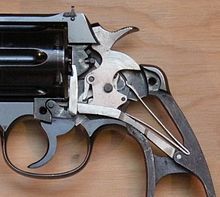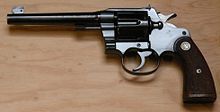Colt New Service revolver
The Colt New Service revolvers were purchased from Colt's Patent Firearms Manufacturing Co. in Hartford manufactured, Connecticut, USA from 1898 to 1944. It was a large-framed 6-shot revolver with a swing-out drum, which was suitable for the use of modern large-caliber ammunition.
history
After the US armed forces replaced the Colt Single Action Army orderly revolver with the newly developed Colt Model 1889 Navy and 1892 Army in .38 Long Colt caliber in 1892, they found that these double-action revolvers with swiveling drums had not proven themselves . the .38 cartridge was too weak, it lacked the man-stopping effect . On the one hand, this led to the development of a self-loading pistol , the Colt M1911 in .45 ACP caliber, and on the other hand, Colt developed the large-framed New Service revolver with a swiveling drum for the .45 Long Colt cartridge. From 1898 to around 1945, around 356,000 copies of the New Service revolver were produced in a series of serial numbers in various variants.
technology
While the 1889 Navy and 1892 Army double-action revolvers still had locks that largely corresponded to those of the Colt Double Action Revolver Model 1877 and 1878 with a leaf spring, the Colt New Service models were a further development of that by M. Kaufmann and J. Warnant in England patented revolver lock, which was also used in Webley and Enfield revolvers (Br. Pat. 4302/1880). The lock has a two-legged mainspring that also serves as a return spring for the cock and holds the drum transport lever in the forward position. In addition, the drum, which can be swiveled out to the left, does not rotate to the left like that of the 1889 Navy and 1892 Army revolvers, but to the right.
After 1905 (approx. From serial number 12,000) a "hammer block" was also built in to prevent a cartridge from igniting if the trigger was not pulled. At about the same time, the firing pin firmly inserted on the hammer was abandoned, the firing pin inserted with play allowed the ignition hole to be drilled more precisely or smaller within the frame.
The New Service revolvers came as standard in barrel lengths from 2 to 7½ inches and in various calibers, .38 Long Colt, .38 Special , .38-40 WCF , .44-40 WCF , .44 S&W Special, .45 ACP , .45 Long Colt , .450 Eley, .455 and .476 Eley and from 1935 in caliber .357 Magnum .
New Service .45 Long Colt, .455 and .476 Eley
The first New Service revolvers were manufactured as large-caliber military weapons in the common calibers of the US Army (.45 Long Colt) and the British Armed Forces (.455 Eley) with 5½-inch barrels and were made available for tests. The US Army acquired only a few of these weapons; they still had a large number of Model 1873 single-action revolvers and .38 double-action revolvers in stock. New Service revolvers were used in large numbers in the British armed forces, some of which were privately procured by officers. Army weapons were delivered with smooth walnut grip panels and sling swivels.
In a Colt catalog from 1898, these weapons with fixed sights and hard rubber grips with a Colt medallion embossed on top, with barrel lengths of 4½-7½ inches in calibers .45 Long Colt, .44 Russian, .38-40 and. 44-40 offered. The caliber designation for the latter two cartridges, however, was "38 Colt's New Magazine Rifle" and "44 Colt's New Magazine Rifle".
New Service Target Model
The New Service Target model, a weapon specially designed for sport shooting, was supplied with 7½-inch barrels. The frame bridge over the drum was flat, the visor was laterally adjustable with a screw and the front sight was adjustable in height. In addition to the calibers commonly used in the USA, it was also manufactured for shooters in Great Britain. The barrels for the Eley calibers used there were provided with Metford rifles.
An advertisement in the American journal "Shooting and Fishing" shows that the New Service Target revolver was already used in 1900 at international shooting events.
These guns between serial numbers 30,000 and 50,000 in caliber .45 Long Colt, acquired by the US administration before the First World War, have a 5½-inch barrel, fixed sights, smooth walnut grip scales and are fitted with a sling swivel.
The weapons delivered to the army bear the inspector's mark RAC (Rinaldo A. Clark) and the lettering UNITED STATES PROPERTY on the underside of the barrel. On the underside of the handle they are marked US ARMY MODEL 1909 No. xxx labeled (the number does not correspond to the serial number).
The weapons handed over to the Navy are stamped VP (Verified Proof) on the left side of the frame, on the underside of the handle is USN (anchor) No. xxx.
The weapons that were given to the US Marine Corps are rare . These have fluted walnut handles that are slightly rounded at the bottom. On the bottom of the handle they are labeled USMC No. xxx.
Model 1917 cal. 45 ACP
In contrast to the 1909 model, this weapon, ordered by the US Government after the start of World War I, fires .45-ACP pistol ammunition, which is loaded in half-moon clips of 3 cartridges each. The clips are used to fix the rimless cartridges in the drum and to enable them to be ejected with the star-shaped central ejector. The barrel length of 5½ inches corresponds to that of the 1909 model, but the barrel tapers towards the muzzle. In addition, the rear drum is slightly shorter to accommodate the clips. 151,700 specimens of this weapon were made, at the same time Smith & Wesson manufactured 163,476 of their variant of this revolver, the S & W .45 Hand Ejector Model 1917, according to factory records . The surface treatment of all these revolvers originating from war production is a little rougher than that of civil weapons.
The New Service Model 1917 revolvers remained with rearward US troops such as the military police until 1945. After 1944 around 1000 Model 1917 revolvers were assembled from surplus parts for the civilian market. These weapons, manufactured between serial numbers 335,000 and 336,000, have the barrel inscription COLT MODEL 1917.45 AUTO.CTGE on the side.
New Service Shooting Master
The Colt Shooting Master , a refined version of the New Service Target model, was launched as a sporting weapon with a 6-inch barrel (other barrel lengths were not available) in various calibers towards the end of the 1920s. From 1935 it was also available in the .357 Magnum caliber. In contrast to the Target model, the transition to the grip base was slightly rounded.
Use in the civil sector
In addition to being sold to private customers, the New Service was used in large numbers by government organizations and police services because of its robust structure. Customers were the North West Mounted Police, forerunner of the Royal Canadian Mounted Police , the Ejercito de Cuba, the San Antonio Police Department, Texas (SAPD), the US Border Guard (UIBP) , the Texas Public Savety Dept. and many more.
Also of interest are the guns modified by Colt employee J. Henry Fitz-Gerald with a 2-inch barrel, the trigger guard removed from the front and the cockspur removed.
See also
literature
- The Book of Colt Firearms , 1971 by Sutherland & LRWilson.
- A History of the Colt Revolver from 1836 to 1940 1940 by Haven & Belden, Bonanza Books, New York.
- Colt Firearms from 1836 1981 by James E. Serven, Stackpole Books, Harrisburg, PA, USA, ISBN 0-8117-0400-9 .
- Modern handguns and their use 1911 by Gerhard Bock, Verlag J. Neudamm.
- The Revolver 1865-1888 1966 by AWF Taylerson, published by Herbert Jenkins, London GB.
- Smith & Wesson 1977 by Roy G. Jinks, German edition Verlag Stocker Schmid AG, Dietikon, Switzerland, ISBN 3-7276-7025-8 .



